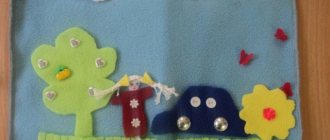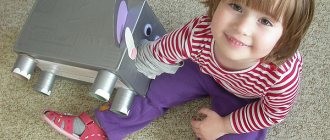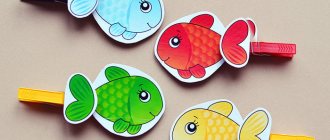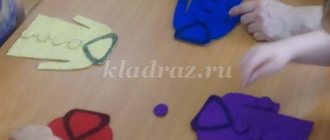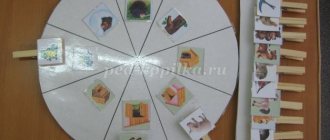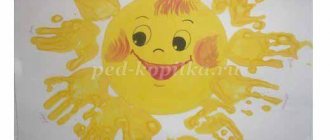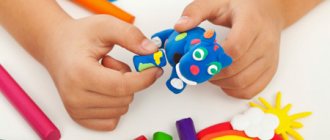Progress of the game:
Using sample cards , you need to complete laying out tasks
patterns, loops, tying knots and tying ropes. First, thread patterns must be laid out directly on the sample, and when the execution is mastered, on a separate card .
"Color it right"
.
Goals: develop fine motor skills ; learn to hatch objects with an inclination to the right, left, straight, with lines parallel to each other.
Game material and visual aids: pencils, outline images of various objects.
Description: Children are invited to take part in a competition for the best hatcher. The teacher distributes contour images of objects, explaining the principle of shading (lines parallel to each other, slanted to the right (left, straight)
.
"Handshake"
Goal: development and training of coordination of finger movements.
Equipment: hand expander (rubber ring)
Progress of the game:
the child places his fingers near the first house. Then he starts with his fingers
move along the islands to another house without taking your fingers off the other
"bumps"
.
Rules:
1. you can move, for starters, using 2 fingers;
2. all fingers must be involved;
3. You cannot tear off the first finger without moving the other one.
Working with mosaics
Goal: development of fine motor skills , coordination of finger movements.
Equipment: mosaics of various types, samples of laid out figures.
Lay out several columns of plates of the same color. Lay out a mosaic design with a sample in front of your eyes. Make your own drawing based on past experience.
"Thread patterns"
Goal: To teach children to perform patterns using sample cards , to develop fine motor skills and hand-eye coordination.
Equipment: thick heavy threads or thin ropes; cards - samples .
MAGAZINE Preschooler.RF
“Development of fine motor skills in preschool children through didactic games”“The origins of children’s abilities and gifts are at their fingertips...” V.A. Sukhomlinsky
The problem of developing fine motor skills in preschool children is reflected in the “Federal State Standard of Preschool Education” . Fine motor skills are the ability to perform precise, coordinated movements with the fingers and hands. Fine motor skills are not only necessary in everyday life, they have a great impact on the child’s learning process. That is why, when diagnosing readiness for school, much attention is paid to how well the fine motor skills of preschoolers are developed. Fine motor skills are important when learning to write and draw: a person’s handwriting will, in particular, depend on the degree of development of these skills. In addition, the development of fine motor skills is closely related to the development of speech, since the areas of the cerebral cortex responsible for these functions are located very close to each other.
It is in preschool age that special attention should be paid to the development of fine motor skills: by the time the child goes to school, his motor skills must be developed at a sufficient level, otherwise learning at school will be difficult.
Working with preschool children, I encounter children’s problems such as poor development of the hands, impaired motor skills of the hands; in such children, slowness in performing movements predominates, and stiffness is observed. The child encounters problems when completing tasks, begins to be capricious, and his mood deteriorates.
Understanding the importance of this problem, I set myself goals and objectives.
Goal of the work:
- Development of fine motor skills in preschool children through didactic games.
Tasks:
- Improve the subject-development environment of the group for the development of fine motor skills.
- Develop fine motor skills of fingers in preschool children through educational games and toys.
- To develop the tactile sensitivity of children’s hands through didactic games and finger gymnastics.
Expected result:
- The subject-development environment has been improved;
- Positive dynamics in the development of children’s fine motor skills;
- Increases children's confidence in completing tasks and improves their mood.
Novelty:
It consists in revealing the theoretical, practical justifications for the psychological and pedagogical conditions for the development of fine motor skills of preschool children through methods and techniques, and also reveals the features of work in this direction and the effective way of its implementation.
At the beginning of her work, she conducted a diagnostic examination of the state of fine motor skills in children with the goal of identifying the level of development of fine motor skills of the hands. Diagnosis was carried out according to the following criteria:
Exercise "Lanterns" ; clenching and unclenching fists; rubbing fists; crumpling paper in a fist. The criteria are divided into three levels: high, medium, low. High level: accurate motion reproduction. Intermediate level: the basic elements of the movement are completed, but there are inaccuracies in execution. Low level: absence of basic elements in the movement structure. The diagnostics of the development of fine motor skills showed that 70% of newly arrived children have a low level of development of fine motor skills, and 30% have an average level of development.
The work was carried out in stages. At stage I, work was carried out with children, at stage II, work was carried out on joint activities of children with each other, individual work. At the third stage, work was carried out with parents: folders were made and displayed for parents: “Didactic games for the development of fine motor skills” , “Articulation exercises” , “Finger gymnastics” . Meetings were held, as well as individual conversations with parents of children with insufficiently developed hand motor skills “Developing fine motor skills at home” , simple games were offered, such as playing with sand “Find what’s hidden” , “Games in the kitchen” , working with mosaics , massage of the hands using various objects (cones, Sujoku balls, pencil).
To accomplish the assigned tasks, various methods and techniques were used:
Verbal method - verbal appeals from the teacher to children, explanations when examining visual objects. Since at the stage of formation of speech development it is difficult to simultaneously perceive the display of objects, actions with them and speech information, the explanation should be extremely brief: every extra word distracts the baby from visual perception.
A visual and effective method of teaching - at a young age, as is known, children become familiar with the objects around them through visual and sensory accumulation of experience: they look, pick them up, feel them, and in one way or another act with them. Taking into account this age feature, I try to widely use visual techniques: I show the object, give the opportunity to touch it, examine it.
Practical method - in order for knowledge to be acquired, it is necessary to apply it in practical activities. After a general demonstration and explanation, I propose to perform, under direct supervision, a fragment of the didactic game separately for each child, providing differentiated assistance as necessary, and giving individual instructions.
Game method - game methods and techniques occupy a large place in the education of preschool children. These include didactic games that raise their interest in the content of learning and provide a connection between cognitive activity and play activities characteristic of children. I often use game techniques; they help me a lot in getting children interested and learning the material better and faster.
To successfully solve the assigned problems, I selected and studied methodological literature on this topic: “New games with fingers for the development of fine motor skills” , Avanesova V.N. “Didactic games as a form of organizing education in kindergarten” , I.A. Ermakova “Developing fine motor skills in children”; A.E. Belaya “Finger games for the development of fine motor skills” ; as well as the monthly magazine "Preschool Education" . Based on this literature, I developed a long-term plan for the “Miracle Fingers” for the development of fine motor skills. I tried to create an environment surrounding the children in such a way that it determined the direction of their activities and at the same time solved the task of developing fine motor skills. The group has created the necessary subject-development environment, acquired games and aids for the development of fine motor skills, most of which were purchased and made independently and with the help of parents (during an announced competition in the group).
Conclusion:
By creating in the group the necessary developmental environment that promotes the development of fine motor skills, taking into account the age characteristics of children, receiving the support and assistance of parents helped to achieve the goal. Thus, as a result of the work done, I came to the conclusion that targeted, systematic and systematic work on the development of fine motor skills of children’s hands contributes to the formation of intellectual abilities, has a positive effect on the speech zones of the cerebral cortex, and most importantly, helps to preserve the physical and mental health of the child.
I would like to continue working next year on making and studying new games and game exercises on this topic.
| Next > |
Progress of the game:
The child takes an expander and squeezes it for each stressed syllable to the beat of the poem.
“I adore all my friends”
E. P. Pimenova. After each line there is a change
hands
"Paper Crafts"
.
Goals: develop fine motor skills , develop the ability to fold a sheet in different directions.
Game material and visual aids: paper.
Description: suggest the game “Paper Toy Store”
.
Then show examples of paper figures that children can make (cap, jackdaw, boat, dove)
.
Games with a pencil.
Equipment: pencils
The children are given faceted pencils. The child places the pencil between the palms and rotates it, moving it from the base of the palms to the tips of the fingers.
Hold the pencil with each bent finger. Hold the pencil with your fingers arranged like this: index and ring fingers on top, middle and little fingers on the bottom.
The game “Why not Cinderella?”
.
Goal: develop fine motor skills .
Game material and visual aids: cereals (rice, buckwheat)
.
Description: the teacher complains to the child that a little trouble happened to him, two types of cereals (rice and buckwheat) were mixed, and there is not enough time to sort through them. Therefore, his help is needed: put the cereal into different jars.
Game "The letter grows"
.
Goal: develop fine motor skills .
Game material and visual aids: sheet of paper, pencil.
Description: the child receives a sheet of paper with letters drawn at opposite ends - one very small, the other very large. Invite the child to depict the process of increasing or decreasing letters, that is, next to the small one, draw a larger letter, the next one even larger, etc. Draw the child’s attention to the fact that the letter should grow little by little, thus bringing the letter to the size indicated on the opposite end of the sheet .
Beads
Goal: develop precision of movements , consolidate knowledge of colors.
What you need: colored pasta, long string.
How we play: we string the pasta onto a string; you can suggest a certain alternation of pasta colors.
"Needles"
Goal: development of tactile sensitivity and complex coordination
movements of fingers and hands.
Equipment: round hair brush.
